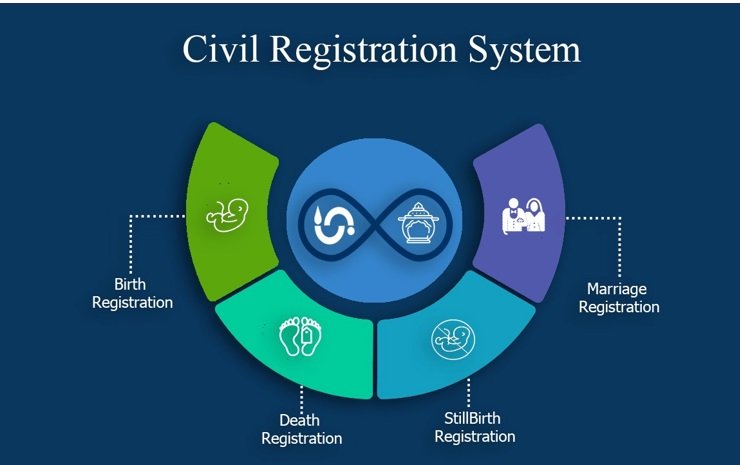
Understanding the Significance of Civil Registration System in India
In the vast expanse of administrative structures in India, the Civil Registration System (CRS) stands as a cornerstone, quietly yet significantly shaping the nation's demographic landscape. Amidst the hustle and bustle of urban life and the serene calm of rural hinterlands, the CRS plays a crucial role in recording vital events such as births, deaths, marriages, and adoptions. Its importance cannot be overstated, especially in the realm of governance, policy formulation, and socio-economic development.
**Foundations of Civil Registration System:**
The roots of the Civil Registration System in India can be traced back to the colonial era, where the British introduced the system to maintain demographic records for administrative purposes. Over the years, this system has evolved and adapted to the changing needs of independent India. Today, it operates under the aegis of the Registration of Births and Deaths Act, 1969, and the Registration of Births and Deaths Rules, 2004.
**Key Components and Operations:**
At its core, the Civil Registration System revolves around the registration of vital events occurring in the lives of citizens. These events primarily include births and deaths, but some systems also encompass marriages and adoptions. In India, the responsibility for maintaining these records lies with the local municipal bodies and village panchayats.
The process begins with the mandatory registration of births and deaths within a specified timeframe. Typically, births are to be registered within 21 days, while deaths are to be registered within 30 days. This registration involves providing essential details such as the date and place of the event, demographic information about the individuals involved, and other pertinent particulars.
**Significance and Impact:**
The significance of the Civil Registration System extends far beyond the mere documentation of events. It serves as a fundamental tool for governance, aiding in the formulation and implementation of various policies and programs. Here's how:
1. **Demographic Planning:** Accurate demographic data provided by the CRS forms the foundation for informed decision-making in areas such as healthcare, education, and social welfare. It helps in identifying population trends, distribution patterns, and demographic disparities, thus facilitating targeted interventions.
2. **Public Health Management:** Timely and accurate registration of births and deaths is crucial for public health management. It enables authorities to track diseases, monitor mortality rates, and plan healthcare infrastructure and services accordingly. Additionally, it aids in epidemiological research and disease surveillance.
3. **Social Welfare Programs:** Many social welfare programs and schemes, such as pension schemes, insurance benefits, and educational scholarships, rely on demographic data provided by the Civil Registration System. Proper registration ensures that eligible beneficiaries receive their entitlements without discrepancies or delays.
4. **Legal Documentation:** Civil registration serves as legal documentation for various purposes, including obtaining identity proofs, availing government services, and asserting rights and entitlements. It provides individuals with a verifiable record of their existence and identity, which is indispensable in a multitude of legal and administrative proceedings.
5. **Human Rights and Protection:** The CRS plays a vital role in safeguarding human rights, particularly in vulnerable populations such as children and women. Accurate birth registration helps prevent issues like child trafficking, child labor, and child marriage by establishing legal proof of age and identity.
**Challenges and the Way Forward:**
Despite its immense significance, the Civil Registration System in India faces several challenges, including inadequate infrastructure, lack of awareness, and compliance issues. To address these challenges and further enhance the effectiveness of the system, concerted efforts are required at various levels:
1. **Capacity Building:** Training programs should be conducted for officials responsible for registration to ensure proper understanding and implementation of registration procedures.
2. **Awareness Campaigns:** Public awareness campaigns should be launched to educate citizens about the importance of civil registration and the procedures involved. This can be done through various channels, including mass media, community engagement, and outreach programs.
3. **Technological Integration:** Leveraging technology, such as digital platforms and mobile applications, can streamline the registration process, improve data accuracy, and enhance accessibility for citizens.
4. **Interagency Collaboration:** Collaboration between different government departments and agencies is essential for data sharing, integration, and cross-referencing, thereby minimizing duplication and ensuring comprehensive coverage.
5. **Community Participation:** Engaging local communities and stakeholders in the registration process can foster a sense of ownership and accountability, leading to higher compliance and better data quality.
In conclusion, the Civil Registration System stands as a linchpin of governance and development in India, providing the vital scaffolding upon which numerous policies and programs are built. By ensuring the accurate and timely registration of vital events, it not only records the milestones of individual lives but also shapes the collective trajectory of the nation towards progress and prosperity. As India marches ahead on its developmental journey, the strengthening and modernization of the Civil Registration System remain imperative for building a more inclusive and resilient society.
